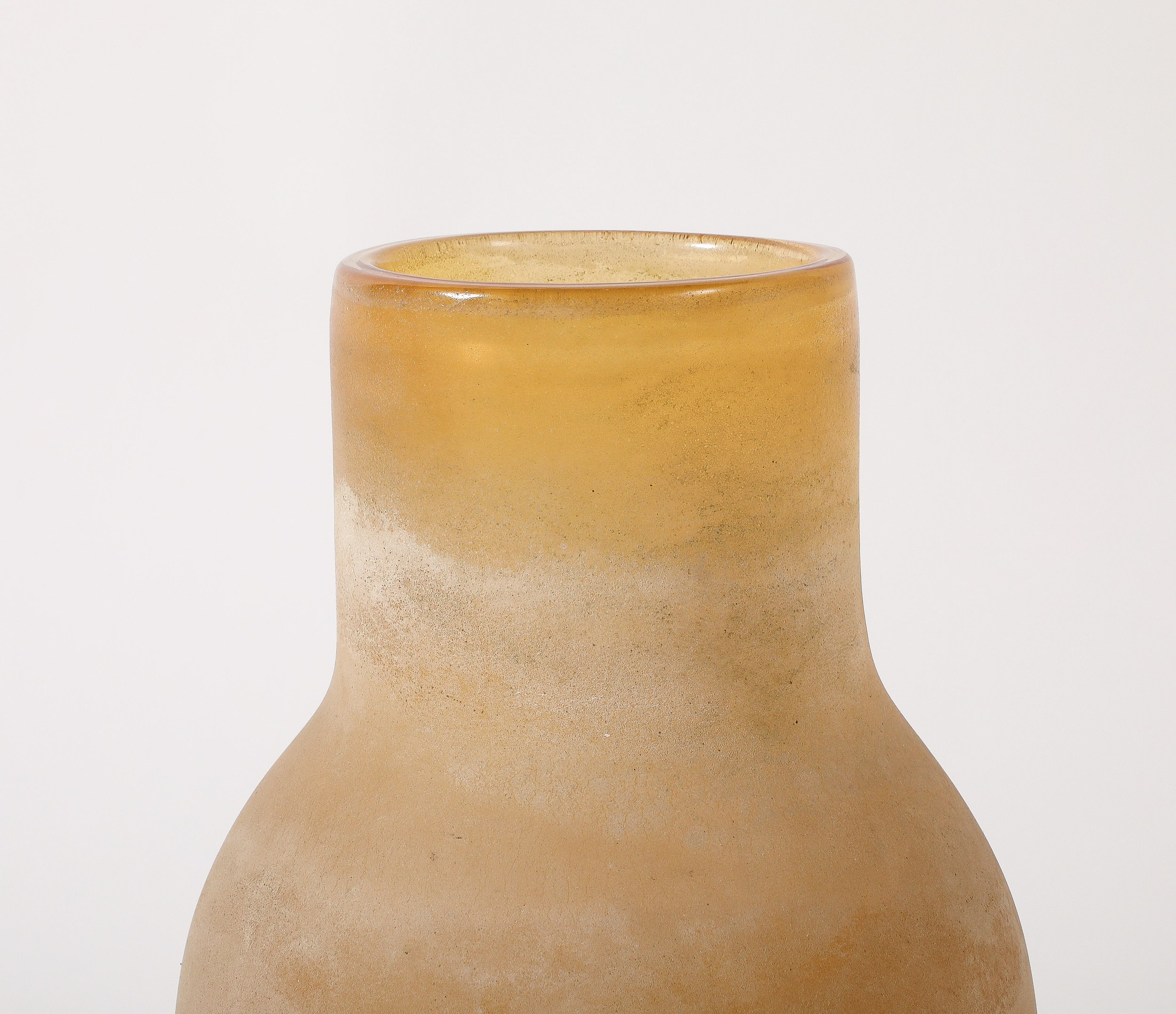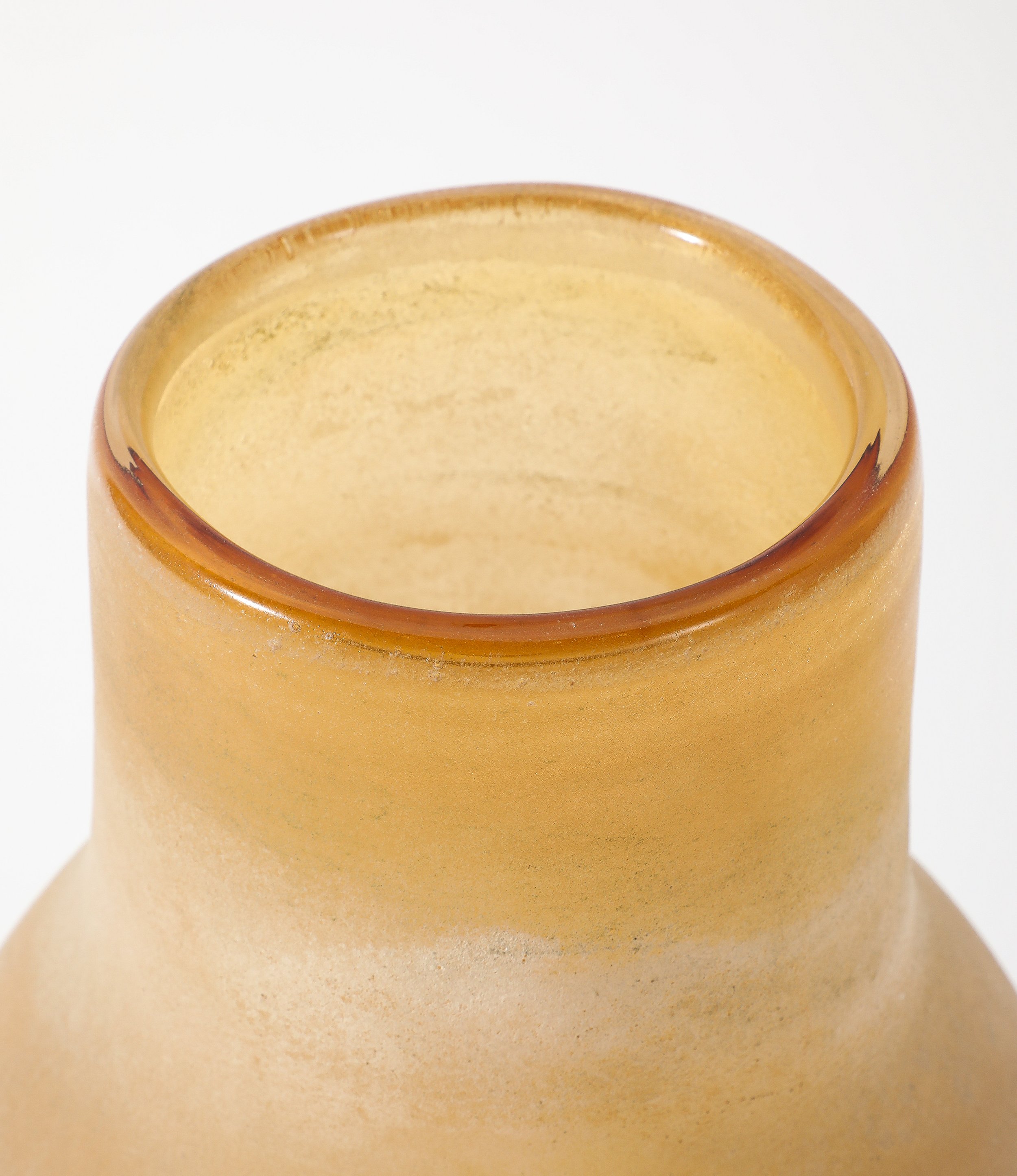 Image 1 of 15
Image 1 of 15

 Image 2 of 15
Image 2 of 15

 Image 3 of 15
Image 3 of 15

 Image 4 of 15
Image 4 of 15

 Image 5 of 15
Image 5 of 15

 Image 6 of 15
Image 6 of 15

 Image 7 of 15
Image 7 of 15

 Image 8 of 15
Image 8 of 15

 Image 9 of 15
Image 9 of 15

 Image 10 of 15
Image 10 of 15

 Image 11 of 15
Image 11 of 15

 Image 12 of 15
Image 12 of 15

 Image 13 of 15
Image 13 of 15

 Image 14 of 15
Image 14 of 15

 Image 15 of 15
Image 15 of 15
















Seguso Vetri d'Arte, 'Scavo' Glass Vase Murano, Italy, circa 1970
Monumental and elegant Italian 'Scavo' amber and brown colored vase by Seguso Vetri d'Arte Murano, Italy, circa 1970. Elegant in form and showing extraordinary craftsmanship with the use of the 'Scavo' technique to replicate the look and feel of ancient Roman archaeological glass. Very beautiful and rare piece, this stunning vase was handblown on the Venetian island of Murano by Seguso, one of Italy's most illustrious producers. The 'Scavo' finished glass, realized in an amber, gold and brown tone, with a dark brown banding offers a beautifully contrasted and muted finish reminiscent of sea glass, Murano, Italy, circa 1970 Seguso Vetri D'Arte
Murano label affixed to the base side.
Signed on underside.
Size: 17" high x 9" body diameter x 4 1/2" base diameter x 5 1/2" top diameter
'Scavo' glass imitates the effect caused by long periods spent underground, typical of glass objects found during archaeological diggings: ancient glass acquires a dusty patina from minerals trickling through groundwater and etching the surface.
During manufacture, a mixture of several powders - mainly carbonates, nitrates, and silica - is dispersed on the surface of the object at a temperature of about 800 Celsius degrees. This mixture adheres irreversibly and gives the special effect of opaqueness and coloring. To improve adhesion the piece is heated again to make the patina permanent. This technique was introduced in the early 1950's by Alfredo Barbini and by Cenedese who were able to use its best effect, applying it in vases and sculptures modeled along archaic lines. Later it gained a remarkable success and was extensively taken up by the Seguso Vetri d'Arte firm during the 1970's
Monumental and elegant Italian 'Scavo' amber and brown colored vase by Seguso Vetri d'Arte Murano, Italy, circa 1970. Elegant in form and showing extraordinary craftsmanship with the use of the 'Scavo' technique to replicate the look and feel of ancient Roman archaeological glass. Very beautiful and rare piece, this stunning vase was handblown on the Venetian island of Murano by Seguso, one of Italy's most illustrious producers. The 'Scavo' finished glass, realized in an amber, gold and brown tone, with a dark brown banding offers a beautifully contrasted and muted finish reminiscent of sea glass, Murano, Italy, circa 1970 Seguso Vetri D'Arte
Murano label affixed to the base side.
Signed on underside.
Size: 17" high x 9" body diameter x 4 1/2" base diameter x 5 1/2" top diameter
'Scavo' glass imitates the effect caused by long periods spent underground, typical of glass objects found during archaeological diggings: ancient glass acquires a dusty patina from minerals trickling through groundwater and etching the surface.
During manufacture, a mixture of several powders - mainly carbonates, nitrates, and silica - is dispersed on the surface of the object at a temperature of about 800 Celsius degrees. This mixture adheres irreversibly and gives the special effect of opaqueness and coloring. To improve adhesion the piece is heated again to make the patina permanent. This technique was introduced in the early 1950's by Alfredo Barbini and by Cenedese who were able to use its best effect, applying it in vases and sculptures modeled along archaic lines. Later it gained a remarkable success and was extensively taken up by the Seguso Vetri d'Arte firm during the 1970's
Monumental and elegant Italian 'Scavo' amber and brown colored vase by Seguso Vetri d'Arte Murano, Italy, circa 1970. Elegant in form and showing extraordinary craftsmanship with the use of the 'Scavo' technique to replicate the look and feel of ancient Roman archaeological glass. Very beautiful and rare piece, this stunning vase was handblown on the Venetian island of Murano by Seguso, one of Italy's most illustrious producers. The 'Scavo' finished glass, realized in an amber, gold and brown tone, with a dark brown banding offers a beautifully contrasted and muted finish reminiscent of sea glass, Murano, Italy, circa 1970 Seguso Vetri D'Arte
Murano label affixed to the base side.
Signed on underside.
Size: 17" high x 9" body diameter x 4 1/2" base diameter x 5 1/2" top diameter
'Scavo' glass imitates the effect caused by long periods spent underground, typical of glass objects found during archaeological diggings: ancient glass acquires a dusty patina from minerals trickling through groundwater and etching the surface.
During manufacture, a mixture of several powders - mainly carbonates, nitrates, and silica - is dispersed on the surface of the object at a temperature of about 800 Celsius degrees. This mixture adheres irreversibly and gives the special effect of opaqueness and coloring. To improve adhesion the piece is heated again to make the patina permanent. This technique was introduced in the early 1950's by Alfredo Barbini and by Cenedese who were able to use its best effect, applying it in vases and sculptures modeled along archaic lines. Later it gained a remarkable success and was extensively taken up by the Seguso Vetri d'Arte firm during the 1970's
